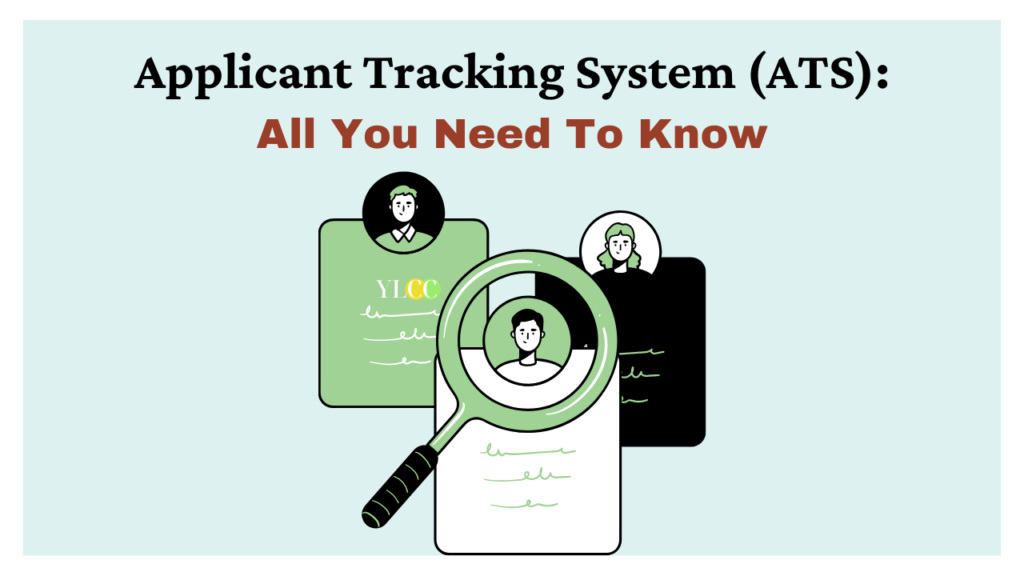
WHAT IS AN APPLICANT TRACKING SYSTEM (ATS)?
An applicant tracking system is any software designed to help recruiters manage the workflows surrounding hiring. An ATS can make it easy to post job listings to multiple locations at one time, for example. However, its primary purpose covers the initial processing and assessment of applications. Instead of tediously sorting through every resume and evaluating its suitability for the job role, the ATS performs some initial analysis on received applications and allows you to filter results and find the most qualified candidates quickly.
In this article, Team YLCC explores everything you need to know about an Applicant Tracking System as a candidate looking to pursue a career in law. Read on!
HOW DOES AN ATS WORK?
There are 4 basic steps to how an applicant tracking system works:
- A job requisition enters into the ATS. This requisition includes information about the position, such as the job title, desired skills, and required experience.
- The ATS then uses this information to create a profile for the ideal candidate.
- As applicants submit their resumes, the ATS parses, sorts, and ranks them based on how well they match the profile.
- Hiring managers then quickly identify the most qualified candidates and move them forward in the hiring process.
It must be noted here that recruiters often filter resumes by searching for key skills and job titles.
HOW DOES AN ATS HELP A LAW FIRM?
Deploying an ATS does require a new investment and the time necessary to set up and start using the software. However, doing so can allow you to realize new process efficiencies that save time and money. The key advantages to using an ATS include:
- Save time at every step of the hiring process, from advertising openings to choosing candidates for interviews.
- Search past and present applications for specific skills, experience, or other attributes that you want to identify for a specific position.
- Boost the likelihood of encountering and interviewing the most qualified candidates for a position by using software that elevates those CVs to the top.
- Make the hiring process smoother and faster for applicants, reducing the friction that can turn away job applicants attracted by your outreach efforts.
- Most importantly, using an ATS helps to avoid bias that can lead to labour law violations and limit diversity in hiring and workforce development. It addresses such areas as religion and ethnicity, especially in screening applicants and resumes by providing a data-driven approach rather than relying on “gut feeling” or “hunches”. An ATS can be programmed to screen for relevant job requirements, experience, and skills rather than biased perceptions of candidates. Focusing on recruiting data rather than recruiter opinions and perceptions helps employers comply with a plethora of labour laws prohibiting discrimination. An ATS improves fairness in the hiring process by removing recruiter bias from the decision-making in various ways. ATS filters perform searches using data points; not recruiter assumptions. They use algorithms to match information using data, taking pressure off recruiters.
- ATS are especially suited for small and medium sized law firms as it saves small employers money on many fronts. It eliminates the need for additional human resources and recruiting staff and helps in understanding businesses’ legal responsibility for maintaining records. Not only does it save money on commissions for staffing agency services, but also on job posting services. It saves time (and by extension money) by automating recruiting communications such as emails for automated acknowledgment of applications received, interview invitations, candidate rejections, job status updates, etc.
However, there are drawbacks too:
- Owing to its automated nature, ATS can undermine its own potential and make companies miss out on highly qualified applicants. The majority of the Applicant Tracking systems make use of artificial intelligence (AI) and have algorithms that search for certain predefined keywords within candidate applications so as to categorize them accordingly. Therefore, Applicant Tracking Systems pose the risk of rejecting highly qualified candidates just because they did not include certain keywords in their job application.
- All the resumes that have an atypical format are usually eliminated since the ATS cannot recognize and interpret them. Applicant tracking systems can straightforwardly reject exceptionally qualified candidates due to technical mishaps or just because their resumes are differently formatted. There are some Applicant Tracking Systems that are not familiar with common fonts like Times New Roman etc. Hence, an ATS can also eliminate applications created using fonts that are not recognized by the system. This way, companies can end up losing on several well-qualified candidates.
- It is a known fact that an ATS, just like any other tool, is open to manipulation. Candidates who are well-versed with the filtering technology of the Applicant Tracking Systems can misuse the same and take advantage of the recruitment procedure. Irrespective of whether the candidate is qualified or not, he/she can simply stuff a resume with the right set of keywords to get selected. Such manipulation of the ATS can be extremely detrimental for businesses and deserving candidates.
FUNCTIONS OF THE APPLICANT TRACKING SYSTEM
- Resume parsing– This is the process of extracting data from resumes, such as contact information, work history, educational background, and skills.
- Advanced search– This enables the employer to filter applications by specific keywords, job titles, skills, experience, education, and more.
- Candidate sourcing– This allows the employer to actively search for, identify, and reach out to potential candidates for open positions.
- Multi-channel candidate sourcing– This feature allow the users to search for potential candidates using multiple channels, including job boards, social media, and employee referrals.
- In-built CRM software– Some ATS also feature CRM software to cover all the hiring needs in one platform.
- Email templates– Most ATS offer email templates to ensure that all the employer’s correspondence with candidates is consistent and professional.
- Advanced analytics and reporting– This allows the employers to generate detailed reports on job seekers, hiring trends, and other data.
- Various integrations– This means the ATS can connect with different types of software, such as email marketing software, accounting software, and CRM systems.
- Ability to schedule interviews– By automating interviews, one will be spared the trouble of rescheduling, sending out reminders, or coordinating multiple calendars.
- Real-time collaboration-This allows people from different parts of the organization to get involved in the sourcing, screening, and decision-making regarding new hires.
- Automation based on certain events and conditions– This means that the ATS will only be triggered to do something if a specific scenario occurs.
HOW TO BEAT THE APPLICANT TRACKING SYSTEM
With time, more and more law firms are adopting Applicant Tracking Systems in order to streamline the hiring process. However, the use of ATS is mostly restricted to the first stage of recruitment, i.e. shortlisting the candidates for an interview. Needless to say, it is important to crack the ATS in order to proceed forward with the interview.
Given below are some key tips that usually work well to convince the ATS:
- Tailor your resume to the job description. It takes more time than using one resume for every job you apply to, but if the company is using an ATS that ranks resumes based on keywords, you have a better chance of ranking high if the terminology in your resume matches what the company requires.
- Avoid stretching the truth and including keywords where you have no experience. As a candidate, your resume might get to the top of the pile, but the recruiter will quickly spot the embellishment and discard it himself.
- Include both the acronym and long form when using a phrase for the first time in a resume. Often, recruiters are not specialists in your field and may not be well versed in its terminology.
- Avoid using images to share information about yourself. If the organization is using resume parsing, the information will not be read and will leave your ATS profile with missing data.
- Ensure your resume is saved as readable text. The easiest way to do this is to submit a Microsoft Word-compatible document or PDF file.
- Use standard section headers that a resume parser will recognize. For example, use “Education” as a header to list the programs you’ve completed.
- Use a simple font, such as Arial or Times New Roman, rather than one that looks artistic but the resume parser may not be able to read properly.
- Watch the junk mailbox in your email software to ensure you don’t miss an email, since the correspondence will often be automated and may look like junk mail.
- Ensure your resume looks professional by correcting spelling and grammar, using headings and ensuring that sections line up correctly.
- Include a good summary at the top of the resume, highlighting what you bring to the organization and not what you want from it. This will likely be the first thing a recruiter looks at if they open your resume.
- If you are asked to answer questions when submitting your resume, keep in mind that some of them may be used as knock-out questions. This means if you don’t provide the answers they want, you will automatically be rejected. Remember that they can see your answers, and if you stretch the truth too much to pass the questions, you may have to explain in an interview why you gave those answers.
- The ATS will track all the jobs you’ve applied to in the past. Therefore, it is better to focus on jobs you are qualified to perform. For example, if you are applying for both individual contributor and director-level jobs, recruiters may find it difficult to gauge your level of experience.
- Apply online even if a friend has offered to submit your resume on your behalf. Most recruiters want all the resumes to be in the system so they’re easier to track. Also, if you do not submit the resume yourself, the recruiter may enter it on your behalf and skip over information you’d like included.
- Some organizations have positions that they are always recruiting for, such as roles that tend to have high turnover. These positions, referred to as evergreen, may always appear on the organizations’ websites, even when candidates have been hired.
- Finally, it is important to remember your username and password so you can log in to update your resume or profile or apply for another position.
YLCC would like to thank its Content Team for their valuable insights in this article.







